Sixty-five percent of the population 15 years old and over were in the labor force
The number of Filipinos 15 years old and over who were in the labor force was at 49.56 million of the estimated 76.60 million population 15 years old and over in 2022. This translates to a labor force participation rate (LFPR) of 64.7 percent or 647 in every 1,000 Filipinos 15 years old and over who were either employed or unemployed. (Table 1)
Among the regions, Region XII had the highest LFPR of 71.5 percent, while Region V posted the lowest LFPR at 62.0 percent. (Table 1 and Figure 1)

Mountain Province registered the highest labor force participation rate in 2022
Among provinces, Mountain Province registered the highest LFPR of 82.0 percent in 2022. In terms of magnitude, this translates to 86.69 thousand Filipinos who were either employed or unemployed. On the other hand, Tawi-tawi registered the lowest LFPR at 53.8 percent. (Table 1)
The distribution of provinces, highly urbanized cities (HUCs) and other areas according to the range of their LFPR is shown in Table 1a. There were 10 provinces and one other area or 9.4 percent of the 117 provinces, HUCs and other areas with LFPR of at least 71.0 percent, and only one province with less than 56.0 percent in 2022. A year ago, nine provinces (7.7%) posted LFPR of at least 71.0 percent but there were seven provinces, HUC and other areas with LFPR of less than 56.0 percent. (Table 1a)
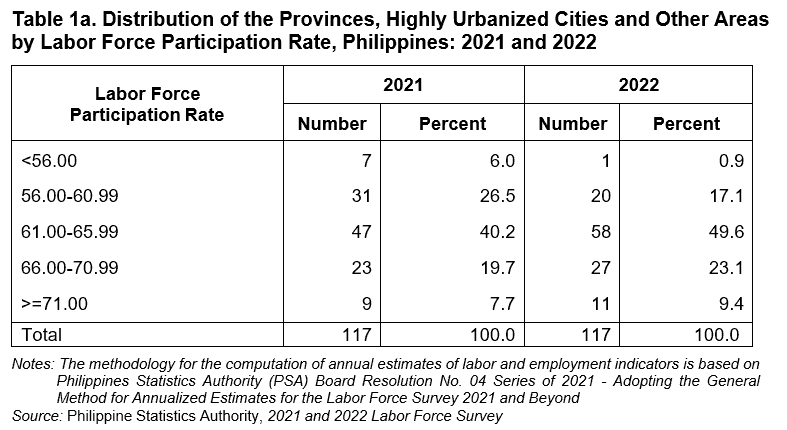
The maps below show that among the provinces, HUCs and other areas, Mountain Province, Bukidnon, Ilocos Norte, Agusan del Sur, Batanes, Zamboanga del Norte, and Lanao del Sur consistently belonged to the group of dark green-shaded provinces or those with LFPR greater than or equal to 71.0 percent in 2021 and 2022. On the other hand, only the province of Tawi-tawi belonged to the group of dark-red shaded provinces or those with LFPR less than 56.0 percent in 2022. (Figure 2)
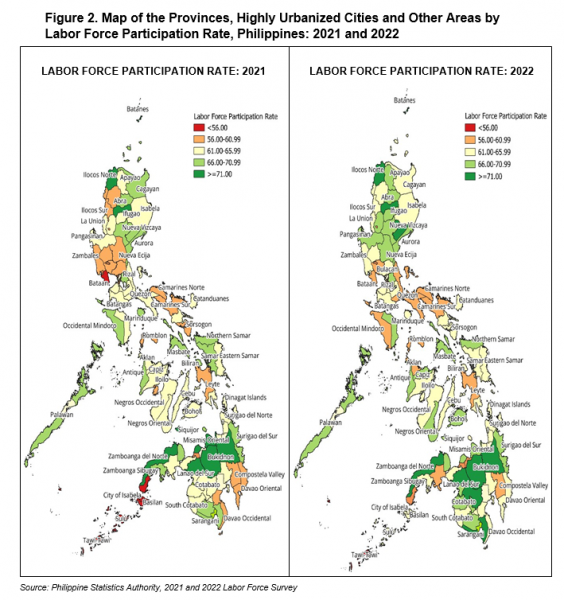
Employment rate registered at 94.6 percent
In 2022, the total number of employed persons was estimated at 46.89 million or 94.6 percent Filipinos who were at work or with a job out of 49.56 million Filipinos in the labor force. (Tables 1 and 2) Among the regions, Cordillera Administrative Region (CAR) and Region XII had the highest employment rate of 96.3 percent each, while NCR had the lowest employment rate of 92.8 percent.
The following regions registered employment rates lower than the national estimate of 94.6 percent: Region V (94.3%),
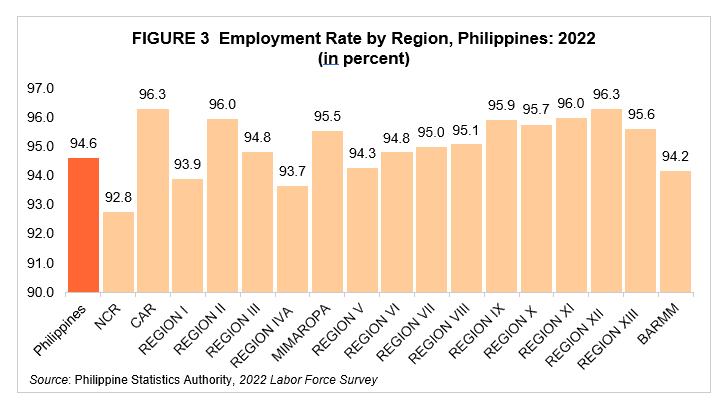
Among the provinces, Mountain Province registered the highest employment rate of 99.1 percent in 2022 or about 85.90 thousand employed persons out of86.69 thousand persons in the labor force in the province. This was followed by Ilocos Norte (98.9%), Kalinga (98.3%), Davao Occidental (98.1%), Nueva Ecija (97.9%), Batanes (97.6%), Samar (97.4%), and Masbate (97.4%). (Tables 1 and 2)
As shown in Table 2a, there were 64.1 percent or 75 provinces, HUCs and other areas with employment rates of at least 94.0 percent in 2022. It may be recalled that the Philippine labor market was still affected by the Coronavirus disease 2019 (COVID-19) especially in the first part of 2021, at which time,
Further, it can be observed that the percentage of provinces, HUCs and other areas with employment rates from 92.0 percent to less than 94.0 percent increased from 24.8 percent or 29 provinces, HUCs and other areas in 2021 to 33 provinces or 28.2 percent in 2022.
It is also worth mentioning that in 2022, no provinces, HUCs and other areas had employment rates lower than 90.0 percent. In 2021, 22 provinces, HUCs, and other areas had employment rates from
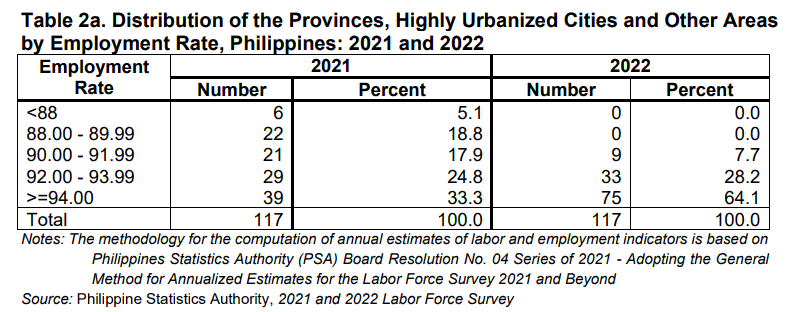
The maps below show the employment rates by group where the dark green corresponds to the provinces, HUCs and other areas with the highest employment rates (at least 94.0 percent); while the dark red corresponds to those with the lowest employment rates (lower than 88.0 percent). It can be observed that in 2022, there were more provinces, HUCs and other areas shaded in light and dark green as compared to 2021. This implies that there were more provinces, HUCs and other areas with higher employment rates in 2022 than in 2021. (Table 1 and Figure 1)

Unemployment rate reached 5.4 percent
Of the total 49.56 million persons 15 years old and over in the labor force, 2.67 million were unemployed which translates to an unemployment rate of
NCR registered the highest unemployment rate in 2022 at 7.2 percent, while Region XII and CAR had the lowest unemployment rate each at 3.7 percent. (Tables 1 and 3)
Unemployment rates in the NCR (7.2%), Region IVA (6.4%), Region I (6.1%), Region V (5.8%), and BARMM (5.8%) were higher than the national figure of 5.4 percent in 2022. (Table 3 and Figure 5)

Among the provinces, Tawi-tawi had the highest unemployment rate of 9.7 percent which translates to a total of 13.55 thousand unemployed persons out of 140.25 thousand persons in the labor force in 2022. (Tables 1 and 3)
The distribution of the unemployment rate of provinces, HUCs and other areas is shown in Table 3a below. It can be observed that there were no unemployment rates greater than or equal to 11.0 percent in 2022 compared with the distribution in 2021. In comparison, there were more provinces, HUCs and other areas that had unemployment rates of less than 5.0 percent or 53 of the 117 provinces, HUCs and other areas compared with 23.9 percent or

Figure 6 presents the unemployment rates among provinces, HUCs and other areas in 2021 and 2022. Comparing 2021 and 2022, it can be observed that there were more provinces, HUCs and other areas shaded with dark green in 2022 than in 2021, implying lower unemployment rates in 2022.

Underemployment rate was lower at 14.2 percent
Employed persons who expressed the desire to have additional hours of work in their present job or to have additional job, or to have a new job with longer working hours are considered underemployed.
The number of underemployed persons was estimated at 6.68 million in 2022. This accounted for 14.2 percent of the total employed persons. (Table 4)
In 2022, Region XII posted the highest underemployment rate of 23.8 percent, while Region X registered the lowest underemployment rate of 8.9 percent.
The regions which posted underemployment rates lower than the national estimate were the following: Region X (8.9%), Region XI (9.1%), NCR (9.1%), BARMM (10.2%), Region III (11.1%), Region I (12.4%), CAR (13.5%), Region VII (13.6%), and Region IX (13.9%).
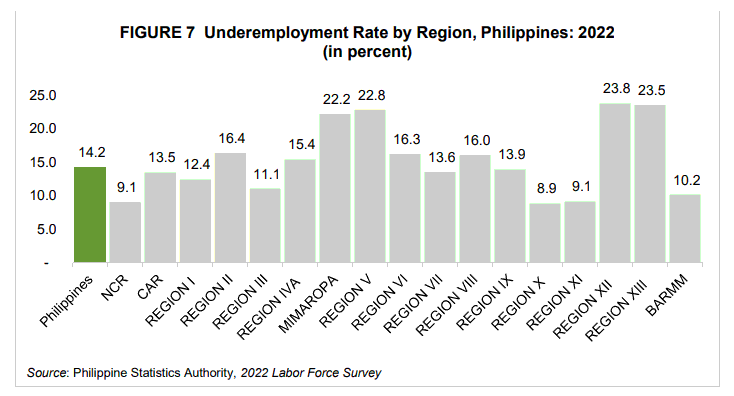
In 2022, two provinces or 1.7 percent of the total provinces, HUCs, and other areas had underemployment rates greater than or equal to 40.0 percent. In 2021, this was higher at 3.4 percent or four of the 117 provinces, HUCs, and other areas. Further, there were more provinces, HUCs and other areas with underemployment rates lower than 10.0 percent in 2022 than in 2021.
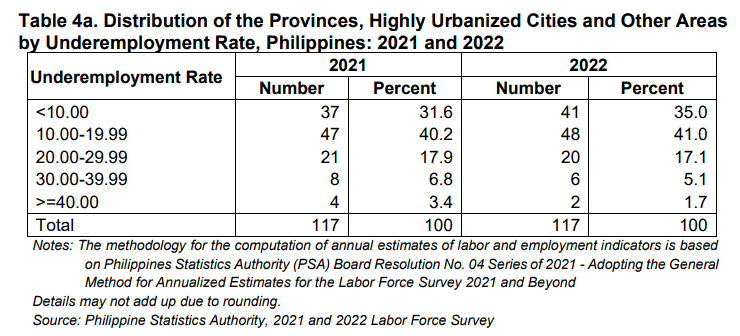
Agusan del Sur had the highest underemployment rate in 2022
Among the provinces, Agusan del Sur consistently registered the highest underemployment rate in 2022 at 47.7 percent, although this was lower than its
In 2021, there were four provinces with underemployment rate greater than 40.0 percent (red-shaded provinces). These were

(Sgd.) CLAIRE DENNIS S. MAPA, PhD
Undersecretary
National Statistician and Civil Registrar General
Note: Based on the Final Estimates of January, February, March, May 2022 LFS and Preliminary Estimates of April, June, July, August, September, October, November, and December 2022.
